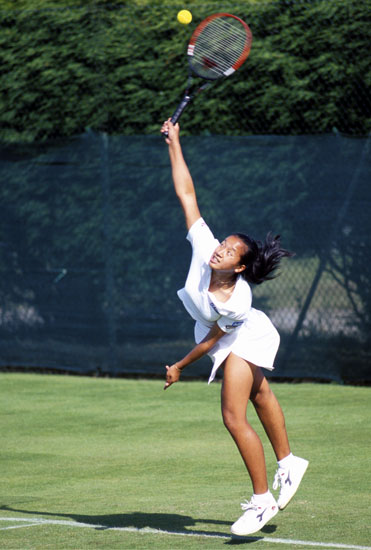 A first consideration is where a photographer is best positioned around the court. At professional matches the photographers are normally allocated locations behind the players at either end of the court, or in the central area adjacent to one end of the net. Where there is a choice, the central area might be the best bet although the end-court locations also produce good shots. At amateur events there is likely to be more freedom to move around and a wider choice of shooting positions, but bear in mind that players can be distracted by movements at critical moments.
A first consideration is where a photographer is best positioned around the court. At professional matches the photographers are normally allocated locations behind the players at either end of the court, or in the central area adjacent to one end of the net. Where there is a choice, the central area might be the best bet although the end-court locations also produce good shots. At amateur events there is likely to be more freedom to move around and a wider choice of shooting positions, but bear in mind that players can be distracted by movements at critical moments.
The player who is serving often makes the easiest subject because he or she occupies a predictable location and the timing of a serve is not too difficult to anticipate. Try to find an uncomplicated background free of distractions and set the lens to its widest aperture and use a fast shutter speed - at least 1/1,000 sec. Use ISO speed as necessary to obtain a suitably fast shutter speed. A lens of about 300mm is ideal on a full-frame DSLR.
The player receiving a serve also occupies a predictable position on the court but in this case it is less easy to anticipate the arrival of the ball. When the ball is seen in the viewfinder, it is too late to depress the shutter release. Watch closely the reaction of the player awaiting the serve, and notice the tension in arm and leg muscles as the ball is served. The sound of the ball being hit at the far end of the court obviously signals the beginning of the critical period. Check captured images to determine whether the timing of the shutter's release is correct, and adjust accordingly.
At the moment of a serve, players jump in the air to gain maximum height and hit the ball as it descends from being thrown a few feet in the air. Timing the release of the shutter to capture the impact of racquet on the ball is very difficult because of the high speeds involved. Human reaction time is typically in excess of 200 milliseconds so there is no point in waiting for the ball to appear in the viewfinder before releasing the shutter. The serve must be anticipated and the shutter pressed before the ball appears in to the frame. With practice, this is not too difficult to achieve.
One good technique is to pre-focus the lens on the position of the serving player, or that of the player receiving the serve, and just concentrate on releasing the shutter at the optimum moment. Tennis balls move so fast that it is impossible to predict the precise location of a ball in the frame. However, experience soon reveals that the ball can be capture in the frame and it is then a matter of taking sufficient shots to capture the peak of the action.
From the ends of the court a photographer of course has a back view of the nearer player. This is normally a disadvantage because the player's face cannot be seen and the expressions that come with effort are lost. From the central area, both players are more or less equidistant and at least some of the facial expressions can be captured. Capturing both players in the same shot is quite difficult to achieve, but it is nevertheless possible.
Remember that not all tennis shots need to capture action. Players invest enormous physical and mental effort in important matches and may often be seen reacting to events in a revealing manner. Important points won and lost often produce interesting physical and emotional reactions, or even a racquet being smashed on the ground. Players sitting on their respective chairs between sets may also reveal exhaustion, despair or other emotions. Finally, a match winning player usually reacts with elation once the final point is secured. catch him or her dropping to their knees or leaping for joy.






